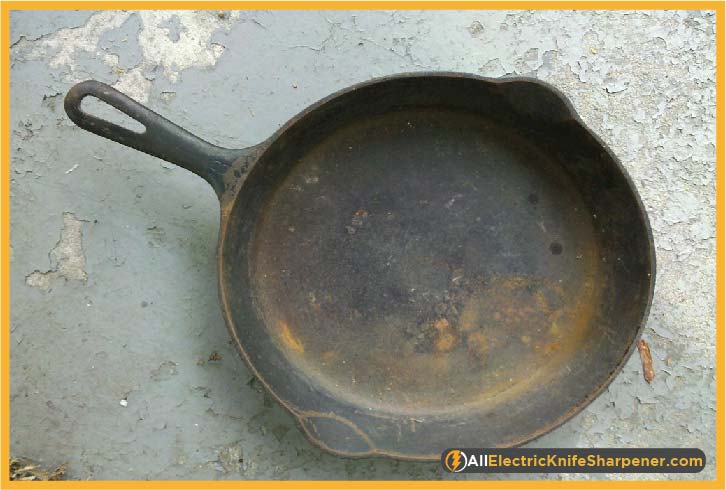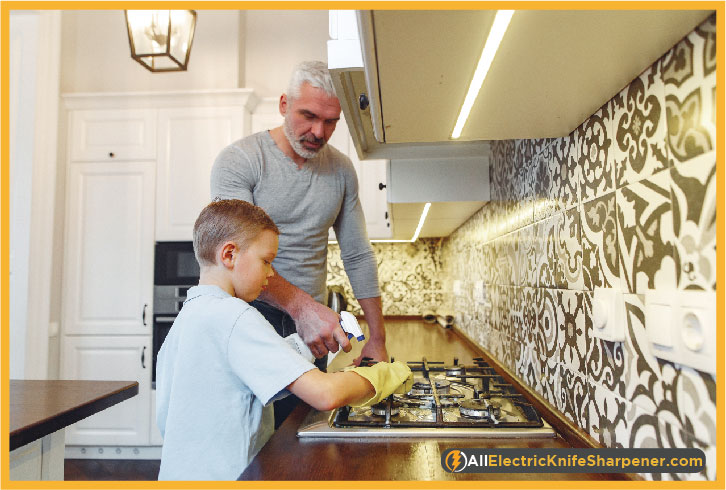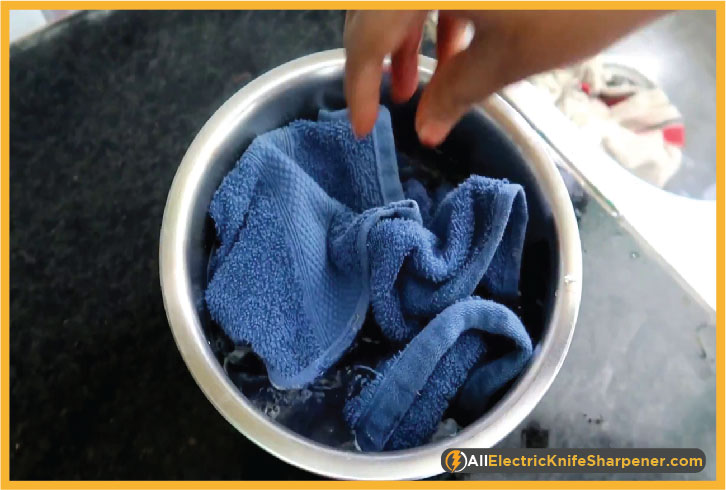Cast Iron has long been associated with strength and character. Throughout history, it has played an important role in countless cultures, helping to shape everything from cooking tools to elaborate architectural structures.
From its ancient beginnings in China to its modern-day implementation in various products and applications, the centuries-old medium remains a reliable fixture at home, work, and play.
In this blog post, we’ll explore the rich history behind cast iron making, highlight some famous examples of how it is used today, and examine what makes it unique enough for our lives even after centuries of use.
Table of contents
Best Ways To Clean Cast Iron?
Cast iron is a versatile and durable cookware that can last for years if cared for properly. One key component of maintaining cast iron is knowing how to clean it after cooking,
But this can be intimidating considering the potentially destructive effects heat and moisture – two essential components in cooking – have on cast iron skillets.
Thankfully, with the right tips and techniques, you’ll be able to keep your cast-iron cookware looking new!
In this blog post, we’ll discuss How To Clean Cast Iron After Cooking and Check out all things cleaning-related. when it comes to caring for your beloved cast-iron skillet or griddle: from what products are best suited for Cleaning, how to go about wiping down surfaces (especially after cooking something incredibly messy!)
as well as some comprehensive guides on preventative maintenance methods that will ensure your kitchen staple will stay healthy in the long run.
With every use of your special cooking equipment come certain expectations: let’s ensure they’re met so you get maximum utility out of each meal!
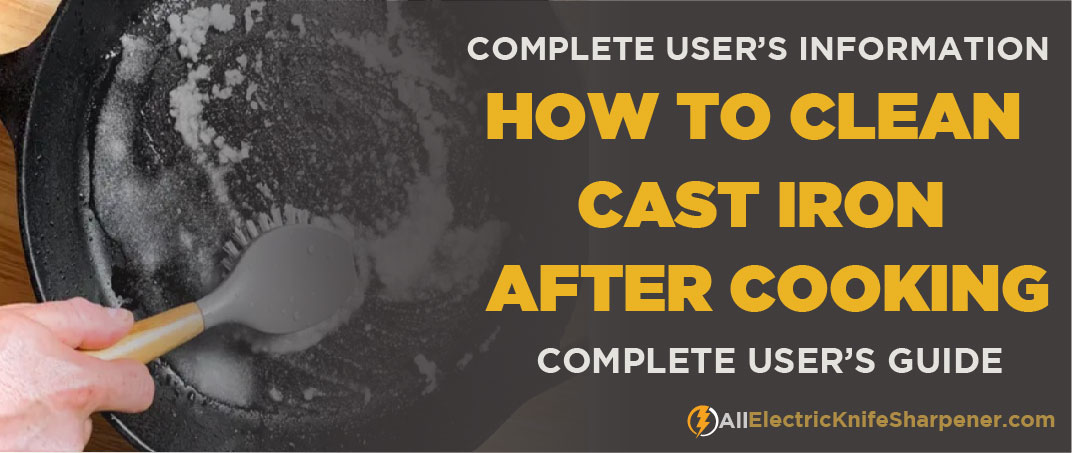
1-What You Need For Cleaning

Before we get into the nitty-gritty of cleaning your cast-iron skillet, let’s review what material you’ll need to have on hand.
A soft sponge or cloth is the most important thing – these are best for wiping down surfaces and absorbing cooking grease.
If you prefer to use something more substantial, like a steel wool pad, make sure it’s a fine grade so it won’t damage the surface of your pan.
You’ll also want to gather some dish soap, an all-purpose cleaner, and coarse salt for any stuck-on bits (but more later).
Finally, having a few paper towels handy is always recommended when dealing with messy spills or streaks.
2-How To Clean & Maintain Cast Iron

Cleaning your cast-iron skillet is quite simple. After finishing cooking:
- Turn off the heat and let the pan cool down before cleaning.
- Once it’s cooled, start by wiping out any excess food with a damp cloth or sponge – this will prevent sticking or burning on future uses of your pan.
- If bits still won’t come up quickly, sprinkle some coarse salt over them and scrub gently with a steel wool pad or brush to remove them.
Once the food is removed from the pan, rinse it thoroughly with warm water (never cold!) and dry it thoroughly with paper towels or a soft cloth.
Lastly, rub a thin layer of vegetable oil or lard over the pan to re-season it, making sure to get into all the crevices.
To keep your cast-iron skillet in its best shape and prevent rusting, wash it with hot water and a mild detergent immediately after each use (before food dries on the surface).
It will help maintain its nonstick qualities and offer longevity.
3-How Much Time Will It Take To Get Spotless?
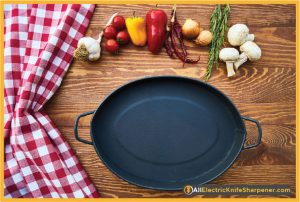
The amount of time it takes to clean your cast-iron skillet will depend on how much food residue is left behind and the type of cleaning products you use.
Generally speaking, a thorough cleaning should take 10-15 minutes.Finally, always store your cast iron skillet in a dry place (and never submerge it in water) – this will help ensure its long life!
With these helpful tips and tricks, you’ll be able to keep your cast-iron cookware looking new for many years to come. So go ahead and enjoy every delicious meal prepared with your trusty pan!
4-How To Remove Rust From Cast Iron
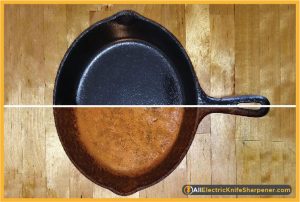
Rust is the enemy of cast iron, so it’s essential to keep your skillet or griddle in good shape by removing any rust that may develop on its surface.
The best way to do this is by using a combination of steel wool and white vinegar – the acidity of the vinegar will help break down any rust buildup, while the steel wool will act as a gentle abrasive.
You’ll want to scrub the affected area with the mixture until all of the rust has been removed, and then rinse off with warm water and dry thoroughly. Suppose you happen to have some baking soda handy.
In that case, you can apply a paste made out of it and water directly on top of any particularly stubborn patches before scrubbing them away.
5-Discover The Best Way to Clean Your Cast-Iron Skillet After Everyday Use!
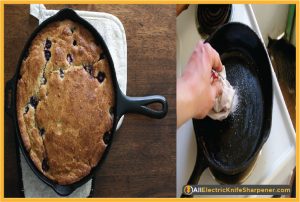
Cleaning your cast-iron skillet may seem daunting, but with the suitable materials and technique, you can ensure it looks as good as new after each use.
Start by cooling the pan entirely before wiping away any excess food or grease with a damp cloth.
If bits still won’t come up quickly, sprinkle some coarse salt over them and scrub gently to remove them.
Once the food is removed, rinse the skillet thoroughly and dry it completely before rubbing a thin layer of vegetable oil or lard over the pan to re-season it.
Wash your skillet with hot water and mild detergent immediately after each cooking session to keep rust at bay.
6-How To Re-Season Cast Iron

Re-seasoning your cast iron skillet is essential for keeping it in good shape and ensuring its nonstick qualities.
Start by thoroughly cleaning the pan with hot soapy water and a stiff brush, removing all old food residues.
Next, dry off the skillet with a paper towel and apply a thin layer of vegetable oil or lard over the entire surface (including all crevices).
Place your skillet in a 350-degree oven and bake it for one hour. Once finished, allow it to cool down before storing away until ready to use again!
With regular re-seasoning, you’ll be able to keep your pan looking new for many years. Now that you know the best way to keep your cast-iron cookware in top shape, you can enjoy every delicious meal with it! Bon Appétit!
Finally, remember to store the pan away after each use. It helps keep it looking new while preventing rust from forming over time. Regular Cleaning and re-seasoning allow you to keep your cast iron cookware in excellent condition for years to come!
Happy cooking!
Why You Need Proper Cleaning?
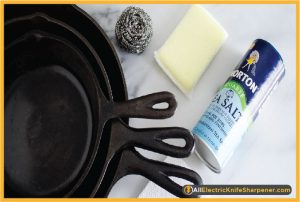
Proper Cleaning is key to keeping your dutch oven and other enameled cast iron in pristine condition.
Begin by removing any food residue or dirt using a soft cloth dampened with hot water and mild detergent.
Make sure you pay special attention to crevices, as these may be harder to reach. Once done, rinse the pan with clean water and then dry it with a paper towel or lint-free cloth.
Avoid using abrasive sponges or brushes to keep discoloration at bay, as these may scratch the enamel.
Additionally, refrain from soaking your dutch oven in water for extended periods—instead, use a damp cloth and warm water to wipe away any dirt or grime on the surface.
Finally, it’s good practice to season your enameled cast iron from time to time.
Our Thinking On Products Explicitly Marketed For Cast Iron
1-Soaps And Scrubs

That is explicitly marketed as a cast iron cleaner and can be an excellent accompaniment to your regular cleaning and maintenance routine.
These products often help to remove cooked-on debris more quickly than traditional clean-up methods, and many contain natural oils that help re-season the iron and keep it from rusting.
However, these products should not replace your regular cleaning routine—it’s still essential to scrub the pan with hot soapy water and a stiff brush.
The key is to balance using effective cleaning products while maintaining your cookware’s nonstick coating.
2-Brushes

Brushes are essential for getting into hard-to-reach corners and crevices of your cast iron cookware. We recommend using a brush with natural, stiff bristles for the best results.
Be sure to use gentle pressure when Cleaning—avoid rubbing too aggressively, as this can damage the nonstick coating on your pan.
3-Chainmail Scrubbers

Chainmail scrubbers are a great alternative to traditional cleaning brushes. Made of stainless steel, these tools are highly durable and can be used for years without showing signs of wear.
They also have the added benefit of being rust-proof, making them ideal for thoroughly cleaning cast iron cookware.
4-Oil
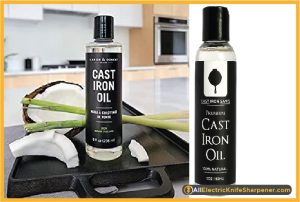
Oil is essential for seasoning your cast iron cookware and keeping it from rusting. We recommend using vegetable oil or lard as these are both highly heat-resistant and will help create a protective nonstick coating on the pan’s surface.
To season, rub a thin layer of oil over the entire surface of the pan before placing it in a 350-degree preheated oven.
Bake it for one hour, remove it to cool down completely, and then you’re ready to cook!
Conclusion
Keeping your cast iron cookware in tip-top condition is essential for its longevity and safety.
With the proper care, you can keep your dutch oven and other cast iron pieces looking new while protecting yourself from rust and other contaminants.
Regular Cleaning with hot soapy water, re-seasoning with oil or lard, and using tools such as brushes and scrubbers will help you maintain your cookware’s nonstick qualities. Happy cooking!
You Might be Intrested to Read More About :How To Make Nitro Coffee
